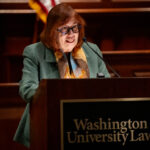Linda Greenhouse, the Pulitzer-Prize winning Supreme Court reporter, said in St. Louis last week that Justice Samuel Alito elaborately reinterpreted a 1990s precedent to “provide to a veneer of legal analysis on what is at its core a religious tract” overturning Roe v. Wade.
Greenhouse added that the “metastasized precedent” Justice Alito created is now being used by conservative judges to limit individual rights, such as those of transgendered children and their parents restricted by a Tennessee law.
Greenhouse made the comments at Washington University Law School on Jan. 15 where she was the featured speaker at the 13th Annual First Amendment Celebration of the Gateway Journalism Review. The talk was co-sponsored by the WashU Law Public Interest Law & Policy Speaker Series and the Weidenbaum Center on Economy, Government & Public Policy.
Greenhouse said that “the little-noticed but potentially significant doctrinal move that Alito made” in Dobbs vs. Jackson Women’s Health Health Organization could be used by conservative judges to limit rights of individual bodily autonomy.
In Dobbs, the Supreme Court struck down not only Roe v. Wade, decided in 1973, but also Planned Parenthood v. Casey in which the court reaffirmed Roe in 1992 with all five of the justices in the majority having been appointed by Republican presidents.
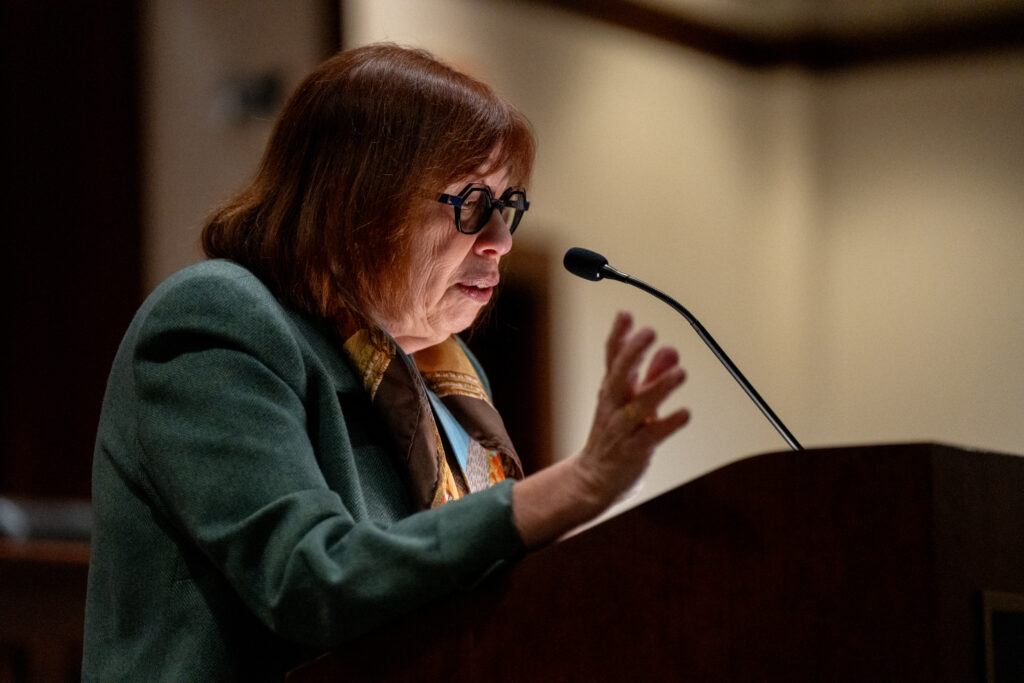
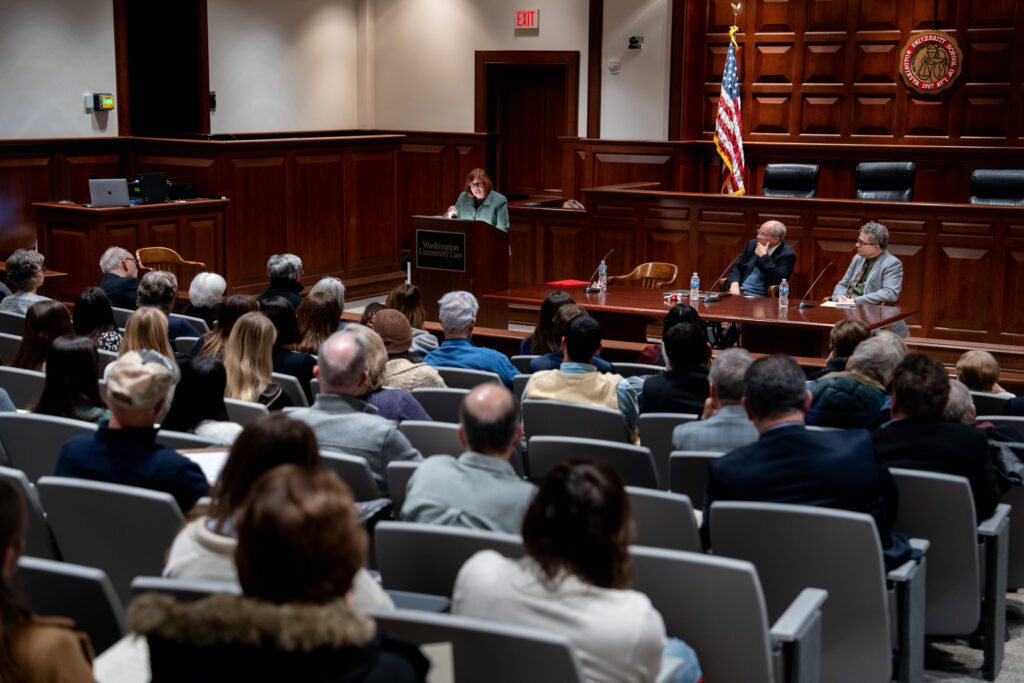
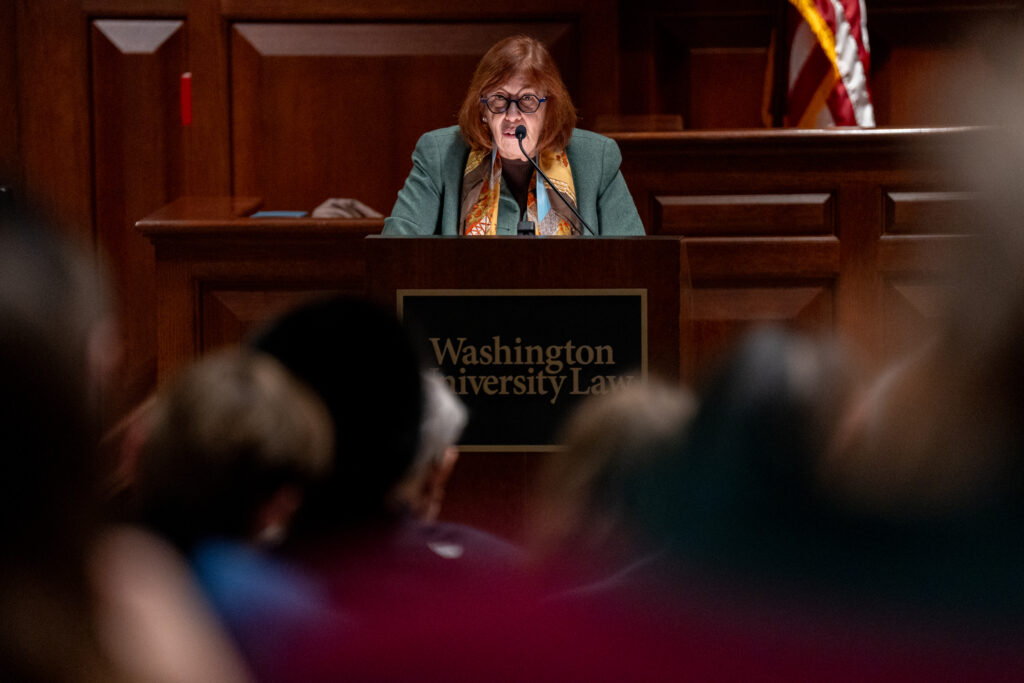
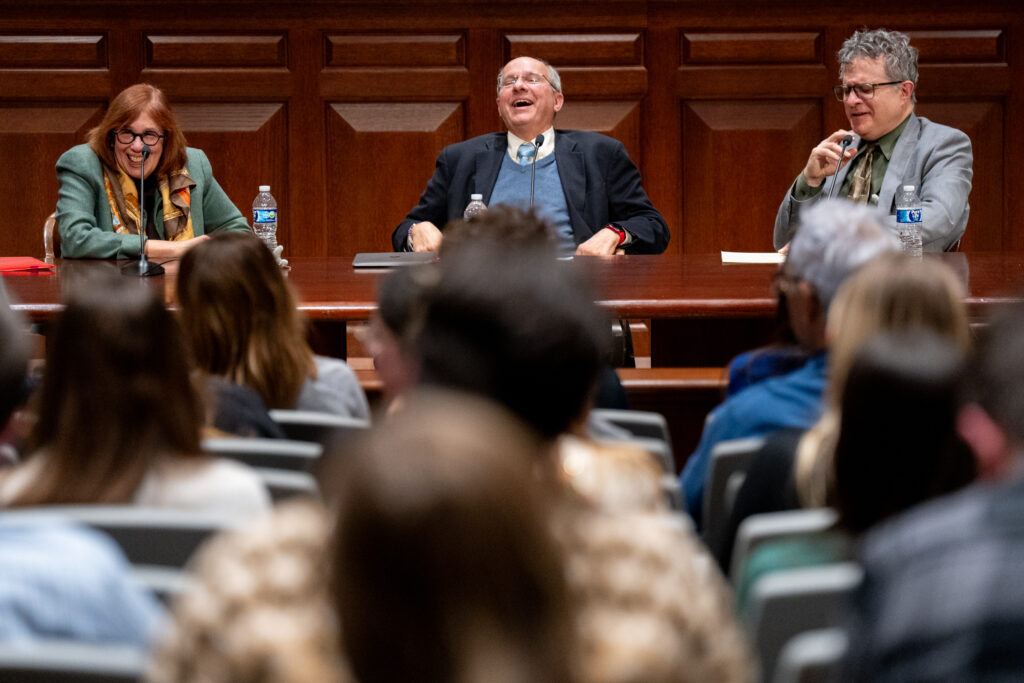
Greenhouse said, “Adherence to precedent is often described as an important, perhaps essential, element of judicial legitimacy. It reassures us that judges, and justices in particular, are ‘doing law,’ in Justice Elena Kagan’s phrase, and not simply freelancing by enshrining their policy preferences in the pages of United States Reports. A rule of precedent provides stability and predictability: the law that meant one thing yesterday will mean the same thing tomorrow. It offers fairness: like things are treated alike.”
But that doesn’t mean that precedents are never overturned. They have been overturned more than 240 times, Greenhouse said. Brown v. Board in 1954 overturned Plessy’s “separate but equal” doctrine and constitutional protection of gay marriage overturned another precedent.
Trump justices key to overturning Roe
In overturning Dobbs, “the role played by the three Trump-appointed justices… is too obvious to require elaboration,” Greenhouse said. “Nonetheless, Justice Alito needed to say something in Dobbs other than that he finally had enough like-minded colleagues to accomplish his long-held goal.”
The 1991 decision of Payne v. Tennessee set out a kind of checklist for when precedent was subject to being overturned.
Alito skipped over some points on the checklist that stood in his way, Greenhouse pointed out. For example Payne said that a closely divided court was one indicator of a precedent that could be overturned; but Roe was decided 7-2
Another factor on the Payne checklist was reliance. Alito maintained he was “unable to find reliance in the conventional sense” in Casey’s acceptance of Roe as precedent. He dismissed Casey as “novel and intangible” and insufficiently “concrete.”
Casey had found reliance in Roe because “people have organized intimate relationships and made choices that define their views of themselves and their places in society in reliance on the availability of abortion in the event that contraception should fail.”
Alito emphasized Payne’s factors of consistency and workability and pointed out that many of the federal appeals courts disagreed on how to apply Casey’s standard that voided abortion regulations that imposed an “undue burden” on a woman’s abortion decision.
Judges chosen for their willingness to overturn Roe
But Greenhouse pointed out that disagreements among the appeals courts resulted from “the steady stream of abortion obstacles that hostile legislatures were continually serving up to the federal courts.
“Alito’s description of inconsistency and unworkability obscured the central fact that the circuits that resisted finding any burden to be ‘undue’ had been stacked with judges chosen for their expressed or assumed opposition to the abortion right. The problem was neither Roe nor Casey. It was a revanchist judiciary, of which Samuel Alito himself is a star member.”
Alito added to the Payne checklist “a consideration of his own devising,” said Greenhouse – “the nature of the court’s error.”
Some precedents “are more damaging than others,” he observed. And Roe and Casey were among the most damaging of all, “deeply damaging,” in fact, for having “usurped the power to address a question of profound moral and social importance that the Constitution unequivocally leaves for the people.”
Alito turned to a 1999 right to die case, Washington v. Glucksberg, in which the court unanimously decided that physician-assisted suicide was not one of the liberties protected by due process in the 14th amendment.
Chief Justice William H. Rehnquist, himself a staunch conservative, wrote in Glucksberg that due process “specially protects those fundamental rights and liberties which are, objectively, deeply rooted in this nation’s history and tradition and implicit in the concept of ordered liberty.”
Justices in the Glucksberg majority made clear in cases that followed that, “History and tradition guide this inquiry but do not set its outer boundaries,” as Anthony Kennedy wrote in the same-sex marriage case. Kennedy added that while Glucksberg’s analysis “may have been appropriate” in the specific context of that case, it was “inconsistent with the approach this court has used in discussing other fundamental rights, including marriage and intimacy.”
History and tradition freezes rights in time
Alito agreed in Dobbs that some rights not mentioned specifically in the Constitution are protected by due process. But he said any such right must be “deeply rooted in this nation’s history and tradition” and ‘implicit in the concept of ordered liberty.”
As examples he cited Loving v. Virginia’s protection of interracial marriage and Griswold v. Connecticut’s protection of contraception – even though those practices were not deeply rooted in the nation’s history or tradition when they were recognized.
But the right to abortion, Alito declared, was “critically different from any other right that this court has held to fall within the Fourteenth Amendment’s protection of ‘liberty.’ ” Abortion, Alito declared, was “fundamentally different” from the rights recognized in those cases. “The existence of the rights at issue in (contraception and same-sex relations) … does not destroy a ‘potential life,’ but an abortion has that effect.”
Greenhouse concludes, “It is here that Alito unmasks himself: the problem isn’t history, tradition or the concept of ‘ordered liberty.’ It is the fetus.”
The reliance on Glucksberg is like “placing a veneer of legal analysis on what is at its core a religious tract,” she said.
Chief Judge Jeffrey S. Sutton applied the same construction of Glucksberg in his decision in 2023 upholding a Tennessee law that prohibits medical treatment for minors suffering from gender dysphoria who seek hormonal treatments that can delay puberty.
Sutton said the transgender teens and their families “never engage with, or explain how they meet, the ‘crucial’ historical inquiry to establish this right. [‘crucial’ from Glucksberg] There is, to repeat, no such history or tradition. Grounding new substantive due process rights in historically rooted customs is the only way to prevent life-tenured federal judges from seeing every heart-felt policy dispute as an emerging constitutional right.”
Greenhouse pointed to the Sutton decision as significant, saying, “The use that an influential appellate judge made of the metastasized precedent foreshadows how Glucksberg will be used in the future.”
Greenhouse pointed out that locking women’s rights in history and tradition froze their freedoms in a time when women couldn’t vote.
Supreme Court not corrupt
Greenhouse made a number of specific observations about the U.S. Supreme Court during her discussions with the school’s law faculty and in a question-and-answer session:
- Even though some liberal audiences think the U.S. Supreme Court is “corrupt,” it isn’t. Justice Clarence Thomas’ acceptance of gifts from Harlan Crowe isn’t significantly different from Justice William J. Brennan Jr.’s, acceptance of gifts from wealthy Washington philanthropist Charles E. Smith. In each case the gifts were in six figures.
- The most serious ethical issue on today’s court is Justice Thomas’ failure to recuse himself from cases involving the Jan. 6 riot, despite his wife’s emails to the White House during the post-election period.
- Chief Justice John Roberts thought he had written a perfectly balanced decision in the Trump immunity case this past spring and was genuinely surprised by the strong criticism he received.
- Justice Brett Kavanaugh often sounds as though he is considering both sides of a legal argument, but almost always comes down on the conservative side.
- The most interesting of the Trump appointees is Amy Coney Barrett, who asked tough questions of a lawyer representing Idaho in an abortion case and who joined with the chief justice and the three Democratically appointed justices in refusing to put off Trump’s criminal sentencing.
- The most fraught issue that might come up between the court and Trump might be Trump refusing to obey an order or opinion of the court.
- Greenhouse once objected to journalists identifying justices and judges by the president who appointed them, but no longer does because of the White House’s strict political vetting of judges before appointment results in a more partisan bench.
- When Greenhouse was a young reporter covering the New York legislature and courts, she appreciated a veteran judge’s willingness to take her into his chambers and explain a difficult point of law. Most judges won’t do that.
William H. Freivogel is the publisher of GJR.
- Opinion: Federal tactics in Chicago ignite fears over First Amendment, due process rights
- St. Louis Magazine to bolster news coverage with new grant
- News analysis: Freedom to read is in peril
- ‘How a journalism professor is redefining inclusion for people with disabilities’
- Opinion: Lambs to wolves — Mainstream media outlets sacrifice transgender community for views, relevancy

